Abstract
Background:
The occurrence of stress and stress related anxiety and depression in medical personnel are being increasingly reported in literature. The perceived stress scale (PSS) is the most widely used psychological instrument for measuring the perception of stress. It is needed to assess perceived stress in our population using appropriately translated version of PSS. The objectives of study were to prepare a Bengali version of PSS-10 and to establish its psychometric properties in the study population.
Materials and Methods:
The study was conducted in a teaching hospital among medical students and interns (N=37). The translated Bengali version and the original English version of PSS-10 were separately handed over to the individual subjects. The scores were compared across different subgroups and psychometric properties of the translated version were assessed using SPSS 16.
Results:
Internal consistency of PSS English (α=0.79) and Bengali (α=0.80) was satisfactory. Intra-rater reliability was adequate (κ>0.5) for most of the items, but showed an inadequate value (κ<0.5) for four items on the scale. After deleting these four items from the Bengali version, a new six-item PSS in Bengali was derived that showed good internal consistency (α=0.699).
Conclusion:
This new version needs to be validated in a larger study population. Perceived stress score using PSS-10 was considerably high in our study population, although there was no significant difference between the subgroups (male/female, intern/student).
Keywords: Perceived stress scale, psychometric property, translation
INTRODUCTION
The concept of stress has been around for centuries, but only recently has it been systematically conceptualized and has become a subject of research, indicating its reciprocal relation with body physiology. The relevance of psychological stress in research leads to the need for valid and reliable instruments to measure it. The perceived stress scale (PSS) is one of the most widely used psychological instrument for measuring the perception of stress.[1] It is a measure of the degree to which situations in one's life are appraised as stressful. Items were designed to tap how unpredictable, uncontrollable, and overloaded respondents find their lives.[1]
The occurrence of stress and stress-related anxiety and depression in medical students, trainees, and qualified physicians are being increasingly reported in literature. Stress is not only a risk factor for several chronic diseases including hypertension, diabetes, and coronary artery disease and precipitates several mental ailments, the impact on stress in the medical work environment affects healthcare delivery as well.[2] The ability to measure stress reliably would be useful to further characterize the link between stress and health. More importantly, it would help evaluate interventions that may decrease stress levels. To the best of our knowledge, no study has been conducted so far using PSS in a Bengali-speaking population, neither has its validity and reliability been tested in this language.
A number of studies[3,4,5] in recent years focused on the incidence of stress and stress-related illnesses such as anxiety and depression among students, trainees, and qualified physicians. Indeed, some research indicate the unique academic challenges of medical studies, rigor of the educational program, and emotionally tense experiences, such as dealing with illness, disease, and dying that make medical students more vulnerable to stress and anxiety than students of other disciplines.[2,6]
A study conducted in UAE among medical students, trainees, and university faculties using a questionnaire based on Cohen's Perceived Stress Scale (English), showed that 65% of the students perceived stress (PS) levels too high. Relationship between stress scores and students’ opinions regarding whether stress perceived was too high or not was significant. No statistically significant gender or stage of medical training differences was found.[4] Similarly, PSS-10 was administered in a multinational study[7] for the purpose of identifying the determinants of stress in dental students. A significant inverse relationship between emotional intelligence and PS was detected. Independent significant predictors of PS identified were gender, previous higher education qualification, and satisfaction with the decision to study dentistry.[7]
In a study conducted in Hong Kong the psychometric properties of PSS-10 (Chinese version) were tested in a large population of Chinese male, middle-aged, smokers suffering from heart ailment.[8] The study showed that PSS-10 not only provides an adequate measure of PS and similar correlations with smoking and health-related measures as the complete version but also shows a higher reliability among Chinese patients. Women reported a significantly higher PS and also higher scores on negative subscale than men.[8] Another study conducted in Greece[6] tested the construct validity, internal consistency, and concurrent validity of the Greek version of PSS-14 and PSS-10 was tested for a population consisting mostly of females of age 55 years, single, and with a full-time job. Cronbach's alpha for positive subscale was marginally satisfactory. Support of the two components in PSS was provided by the opposite correlations of the positive and negative factors. Females exhibited significant higher stress scores.[6]
In the Indian context, students of a medical college in Mumbai showed high stress level, more during their 2nd and 3rd year of their MBBS course. Academic factors were greater perceived as the cause of stress in medical students. Stress was not found to differ significantly on the basis of sex.[3]
The aim of the current study was to establish a valid and reliable version of PSS in Bengali as well as to examine stress level in medical students and trainees of a teaching hospital in a Bengali-speaking set-up.
Objective
To prepare a Bengali version of PSS-10
To establish its psychometric properties in a population of medical students and interns of a teaching hospital
Comparison of PS among different subgroups of medical personnel.
MATERIALS AND METHODS
The study was conducted in Burdwan Medical College Hospital in West Bengal.
The ten-item PSS by Cohen (1983) was translated into Bengali, the scale consisted of four positive and six negative items. Participants are asked to respond to each question on a 5-point Likert scale ranging from 0 (never) to 4 (very often), indicating how often they have felt or thought a certain way within the past month. Scores range from 0 to 40, with higher composite scores indicative of greater PS. Translation was done by two literary experts independently, after which both were matched and a common agreement was reached. It was translated back into English by two health professionals and, when compared with the original version, translation-retranslation validity was found to be satisfactory. The final Bengali version was prepared after reaching a common consensus between all the experts, giving more emphasis on the conceptual and semantic meaning of the questions asked.
All the 2nd MBBS students and interns who attended psychiatry OPD as a part of their clinical posting during the months of May-June and who were able to understand, read, and write both English and Bengali were included in the study after obtaining informed written consent. Socio-demographic and clinical data sheet used in the study included personal information of the subjects as well as the PSS-10 scale. A total of 23 students and 14 interns among them agreed to take part and answered the questionnaire.
English and Bengali version of the scale was handed over to an individual in a random order. Completed data sheet was collected back in 2 days and then the other version was given to the same individual.
For statistical analysis, Statistical Package for Social Sciences for Windows, 16th version (SPSS 16) was used. For descriptive statistics, frequency distribution of the different groups of population and calculation of mean and standard deviation was done. Internal consistency of PSS (English) and PSS (Bengali) and correlation between the scores of the two versions were tested by Cronbach's alpha coefficient and Pearson correlation coefficient, respectively. For assessing the validity of translation, Kappa coefficient value for intra-rater reliability was computed. Student t-test was used to compare the results between different subgroups in the study.
RESULTS
The study involved 37 subjects, mean age of 21.7±2.06 years, majority of the population (N=26) were male (70.3%) with only 11 (29.7%) female participants. Among the 37 subjects, 14 (37.8%) were interns and 23 (62.2%) were students. Mean age for interns (23.7±0.83 years) was found to be significantly different (ρo=0.00) from the mean age of MBBS students (20.48±1.56 years) [Table 1].
Table 1.
Comparison of age and PSS scores among the subgroups

Cronbach's α of the ten-item Bengali scale (0.80) was found to be satisfactory, showing good internal consistency. While computing internal consistency after individual item deleted, item 9 of Bengali scale had α value slightly greater than that of the full scale. Presence of all other items was justified in the scale indicated by their α value [Table 2].
Table 2.
Inter-rater reliability and internal consistency of PSS Bengali (ten item)
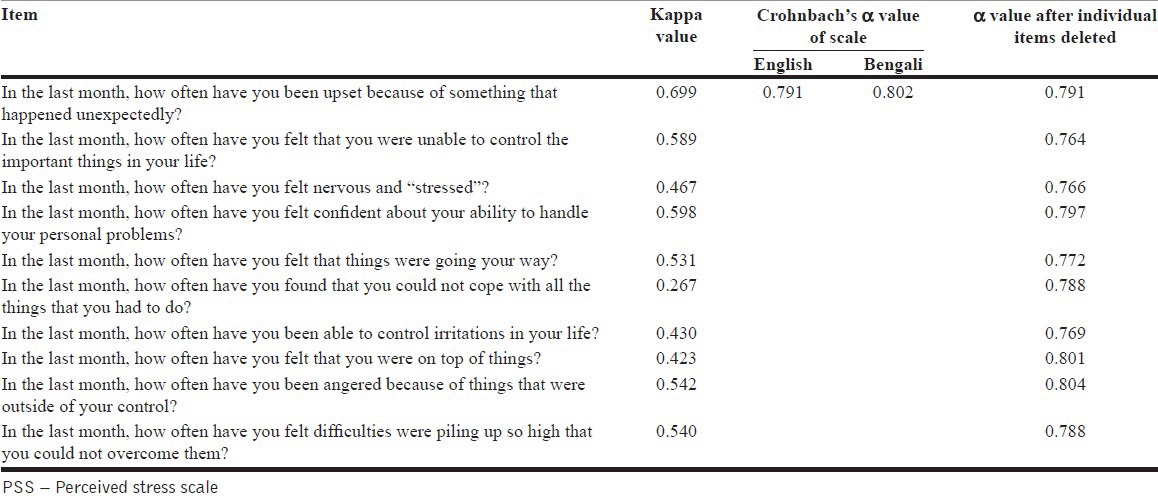
Intra-rater reliability between PSS (E) and PSS (B) was compared using Kappa statistics. Items (1, 2, 4, 5, 9, 10) had satisfactory κ value (>0.5), indicating strong agreement, while items (3, 6, 7, 8) showed disagreement between the original and translated version indicated by (κ<0.5). Deleting these four items from the Bengali scale resulted in a new reconstituted Bengali scale [Table 3]. On exploratory factor analysis, KMO index value (0.72) indicating sampling adequacy was within acceptable limit. The number of factors fulfilling the criteria of Eigen value >1 suggested the presence of two factors [Table 4a]. This was also supported by the scree plot placing factors in decreasing number of Eigen value [Figure 1]. Variance attributed to Factor I was 41.56%, which held the bulk of total variance. Table 4b indicated that, except for item no 5 (which was item 9 in original PSS), the factor structure and individual item loading supports that of PSS English. Item 5 showed higher loading for factor 2, which was contrary to previous study results. The reason for alteration was not sorted out in this study.
Table 3.
Internal consistency of PSS Bengali (six item)
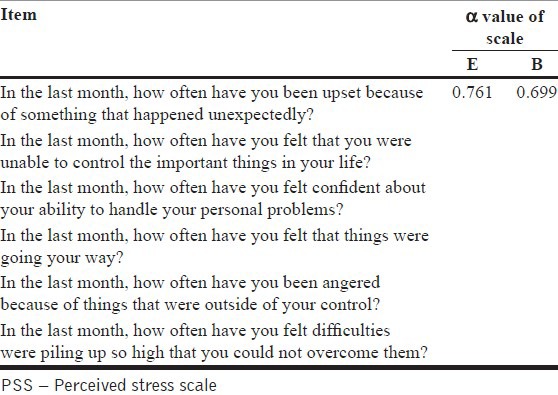
Table 4a.
Factor structure of PSS Bengali (six item composition of two item PSS item) exploratory factor analysis with varimax rotation
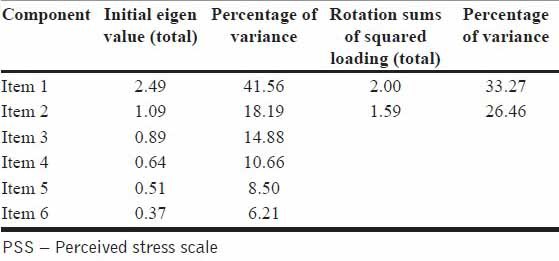
Figure 1.
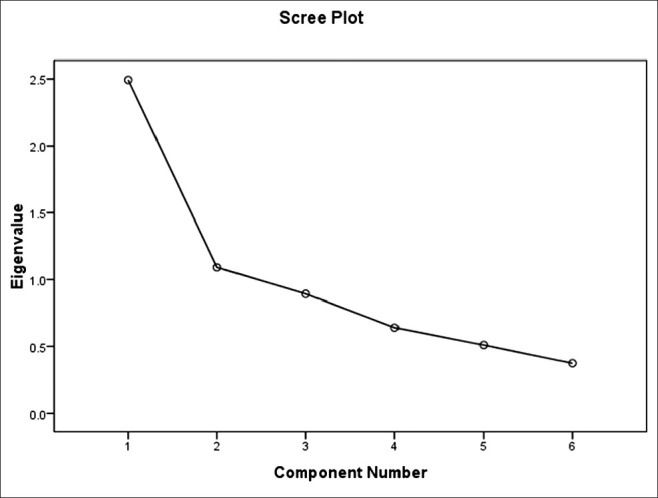
Scree plot indicating the probable two factor structure of the scale
Table 4b.
Item composition of the two factors obtained from PSS Bengali (six item) using exploratory factor analysis with varimax rotation
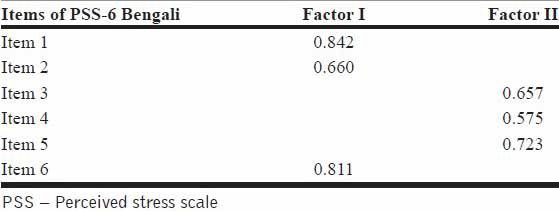
However, to measure PS of the subjects, the current study focused on the findings of PSS-10 original version since it is a pre-validated scale. PS score of the total sample was (19.0±6.89). Independent t-test was done to compare scores between different subgroups (gender, occupation). The difference of PS score between two occupation subgroups (internee, student) was not significant as indicated by their ρ value (P=0.83). When compared between two genders, PS of the male did not differ significantly from that of the female (P=0.46) [Table 1].
DISCUSSION
This was a pioneer study in a Bengali-speaking population, in which reliability of PSS-10 scale was being examined, no other study was found from available resources that had used PSS-10 in medical students or trainees in this part of India. Following methods were adapted during data collection to avoid bias: a) Proformas were given individually to the participants to avoid influence by peer groups, b) collecting data sheet within a short period of time limited wide variation in stress level in the subjects affecting study findings, c) English and Bengali scales were given separately.
Previous studies have found difference in stress level between medical professional and people from other professions.[4] Even among the medical students, different levels of PS was found in different phases of medical course.[2] But the current study did not find interns to perceive stress differently from MBBS students by any significant level [Table 1].
The reliability of PSS-10 English version was been tested in our population. The internal consistency (0.79) was good and comparable with that of pre-validated PSS-10 applied in a US population (0.78).[1] PSS-10 has been translated in different languages around the world. The value of Cronbach's alpha of PSS-10 Bengali is satisfactory (0.80) and comparable with that of PSS Arab (α=0.74), Greek (α=0.82), Spanish (α=0.83), Thai (α=0.85), and Chinese (α>0.5) versions.[5,6,8,9,10,11]
It is evident from this study that there is considerable amount of stress among medical students and internees in a medical college set-up.[12] This finding is supported by previous studies reporting significant stress levels in health professionals; some of these studies used PSS[4,11] and some did not.[2,3] This study does not reveal any significant difference in the PS level in subjects on the basis of age, gender, and educational status, also supported by several other studies.[4,6] Although this is contrary to several other previous study findings that indicate higher PS level in females,[3,5] younger age group, and in subjects with lower academic qualification. One possible explanation may direct toward female minority in our study population.
Some of the items in PSS Bengali (items 3, 6, 7, 8) did not show adequate intra-rater reliability shown by inadequate kappa coefficient value, indicating limitation of culturally valid expression.
CONCLUSION
The sample size of this study being modest, hinders the results to be generalized in wider population. The stress in medical personnel has to be explored in detail through further studies. The newly constructed Bengali version of PSS scale, consisting of the six items with good kappa value has to be administered in a wider population in order to test its psychometric properties.
ACKNOWLEDGMENT
Dr. Paramita Roy, Saptarshi Adhikari: For their valuable suggestion regarding translation of the scale; Interns of batch 2012-13 of BMCH: For their generous help during data collection.
Footnotes
Source of Support: Nil
Conflict of Interest: None.
REFERENCES
- 1.Cohen S, Williamson G. Perceived stress in a probability sample of the United States. In: Spacapam S, Oskamp S, editors. The Social Psychology of Health: Claremont Symposium on Applied Social Psychology. Sage Publications; 1988. pp. 31–67. [Google Scholar]
- 2.Stucky ER, Dresselhaus TR, Dollarhide A, Shively M, Maynard G, Jain S, et al. Intern to attending: Assessing stress among physicians. Acad Med. 2009;84:251–7. doi: 10.1097/ACM.0b013e3181938aad. [DOI] [PubMed] [Google Scholar]
- 3.Supe AN. A study of stress in medical students at Seth GS Medical College. J Postgrad Med. 1998;44:1–6. [PubMed] [Google Scholar]
- 4.El-Gilany AH, Amr M, Awadalla N, El-Khawaga A. Stress among medical and law students in Mansoura, Egypt. Middle East Journal of Family Medicine. 2008;6:31–6. [Google Scholar]
- 5.Ramírez MTG, Hernández RL. Factor structure of the Perceived Stress Scale (PSS) in a sample from Mexico. Span J Psychol. 2007;10:199–206. doi: 10.1017/s1138741600006466. [DOI] [PubMed] [Google Scholar]
- 6.Andreou E, Alexopoulos EC, Lionis C, Varvogli L, Gnardellis C, Chrousos GP, et al. Perceived Stress Scale: Reliability and Validity Study in Greece. Int J Environ Res Public Health. 2011;8:3287–98. doi: 10.3390/ijerph8083287. [DOI] [PMC free article] [PubMed] [Google Scholar]
- 7.Pau A, Rowland M, Sudeshni N, AbdulKadir R, Makrynika E, Moraru R, et al. Emotional intelligence and perceived stress in dental undergraduates: A multinational survey. Crit Issues Dent Educ. 2007;71:197–204. [PubMed] [Google Scholar]
- 8.Leung DY, Lam TH, Chan SS. Three versions of perceived stress scale: Validation in a sample of Chinese cardiac patients who smoke. BMC Public Health. 2010;10:513. doi: 10.1186/1471-2458-10-513. [DOI] [PMC free article] [PubMed] [Google Scholar]
- 9.Elzubeir MA, Elzubeir KE, Magzoub ME. Stress and coping strategies among Arab medical students: Towards a research agenda. Educ Health (Abingdon) 2010;23:355. [PubMed] [Google Scholar]
- 10.Chaaya M, Osman H, Naassan G, Mahfoud Z. Validation of the Arabic version of the Cohen Perceived Stress Scale (PSS-10) among pregnant and postpartum women. BMC Psychiatry. 2010;10:111. doi: 10.1186/1471-244X-10-111. [DOI] [PMC free article] [PubMed] [Google Scholar]
- 11.Wongpakaran N, Wongpakaran T. The Thai version of the PSS-10: An Investigation of it's psychometric properties. Biopsychosoc Med. 2010;4:1751–9. doi: 10.1186/1751-0759-4-6. [DOI] [PMC free article] [PubMed] [Google Scholar]
- 12.Cohen S, Kamarck T, Mermelstein R. A global measure of perceived stress. J Health Soc Behav. 1983;24:385–96. [PubMed] [Google Scholar]


